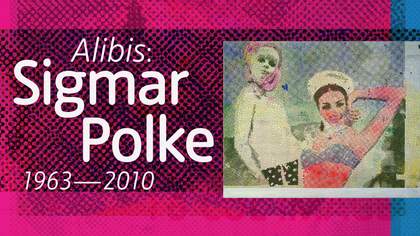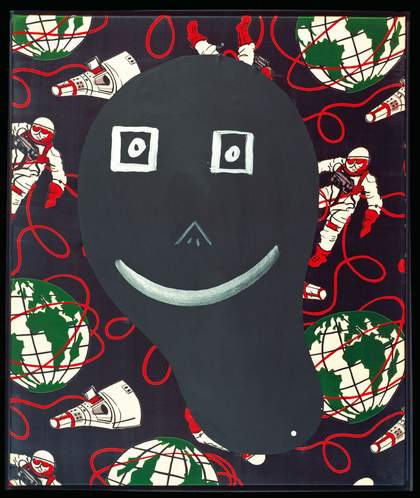
Sigmar Polke
Polke as Astronaut (Polke als Astronaut) 1968
Private Collection
© The Estate of Sigmar Polke / DACS, London / VG Bild-Kunst, Bonn
Mark Godfrey When did you first see Sigmar Polke’s work?
Peter Fischli It was more or less at the same time that I saw the exhibition When Attitudes Become Form [in 1969]. It was at the Toni Gerber Gallery in Bern, and there were the drawings that looked a little bit like potato men – lots of them on brown paper. Of course, my friends and I had seen Polke’s works in reproduction before then. We had talked for a long time about the Flamingos and Higher Powers Command.
MG When did you first meet him?
PF In the mid-1970s. He lived in Zurich and was often at the Fantasio-Bar – one of the three or four places that was open after midnight, which was quite unusual for Zurich.
MG What was he like?
PF He was still in the modus of playing the bad ass – Polke the punk. He was always attacking people, but in a smart way. He had a really good sense of finding a weak or unspoken spot in a person or situation, but he could always change into something charming. You couldn’t really pin him down. He knew how to play it in an ambiguous way.
MG Did he take an interest in young artists in Zurich?
PF No. I mean, to be an artist then was a little bit uncool. At the time, it wasn’t even clear that he was making art. He seemed to be just taking photographs and filming, making things with an unclear status that now feel super-interesting exactly because of that. All these films with double exposures…
MG Did you see those films at the time?
PF No, not the films, but I saw the photographs. I remember him having the camera when he came to the bar, and he was always taking photographs. He wasn’t so much hanging out with artists, but more with what I’d call intellectual hells angels… like high-brow rockers or glam-nouveau bohemians.
MG One of the works that he made in 1976, Giornico, shows a Swiss communist rally on the streets. What drew him to this? It was very unlike him to look at political protest.
PF I always thought that he felt ‘What bigger contradiction could there be than between communism and Switzerland?’ The communists there were a very small group, and from the beginning it was clear that they would never have success. Elsewhere – especially in Germany with the Red Army Faction – the radical left had to be taken seriously.
MG So you think he was amused by the absurdity of the idea of Swiss communists?
PF I can’t really give a definitive answer, but yes. It’s full of weird things, and one could read it like that. Giornico is named after the Swiss town where, in the middle ages, the Swiss won a victory over the Milanese by throwing rocks down the mountains at their troops. A figure from the monument at Giornico appears in Polke’s drawing getting ready to throw a rock, which is similar to the polyhedron in Dürer’s Melancholia. I also wondered if he was aware of the wordplay between Giornico and Guernica…
MG What drew you to Polke’s work before you met him?
PF Well, I felt I understood it because I was very familiar with the balls that had been kicked to him, so to speak, Francis Picabia and Kurt Schwitters. Schwitters for me was an important influence.
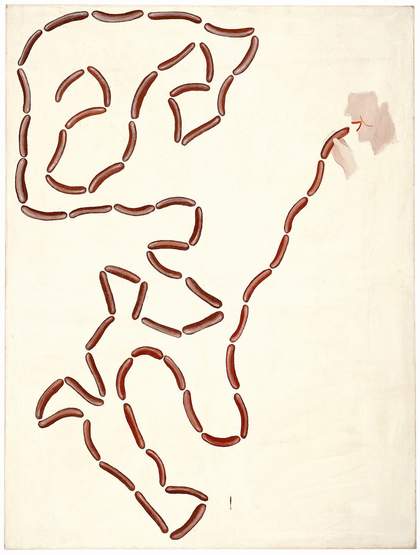
Sigmar Polke
The Sausage Eater (Der Wurstesser) 1963
Dispersion paint on canvas
2000mm x 1500mm
© Estate of Sigmar Polke/DACS 2014, courtesy Friedrich Christian Flick Collection
MG You mentioned his potato-head drawings. What was it about these works and earlier 1960s paintings such as The Sausage Eater that attracted you?
PF Looking at American pop art around 1968, it was really hard for me and my friends to accept that these painters would glorify consumer goods. I was 16 at the time. We could only read their work as a critical, cynical or ironical statement, but we weren’t sure. European pop, such as Richard Hamilton and Polke, was much closer to me, because it was a different kind of pop. The term capitalist realism was very significant to me.
MG So what attitude towards consumer culture did you see when you looked at early paintings of Polke’s such as the Socks or The Sausage Eater?
PF His paintings don’t present icons of consumer culture like the branded products of American pop. It’s always about the world of the petit bourgeois – their aesthetic, their longings, and how they use these consumer items, which are always a little bit on the poor side. I remember the drawing Your little package to the other side, Dein Päckchen nach drüben 1963, which shows how people would neatly package consumer goods and send them to their families in East Germany, to a land where they were neither allowed nor available, which made them more attractive. Polke was also interested in Mad magazine, which we all liked at the time. From the mid-1950s, Mad was already presenting a critique of consumerism in the appearance of a comic. That’s what he picked up on in his drawing Supermarkets. All of which spoke to me more than American pop.
MG What about the style of his mid-1960s drawings? The early Biro ones look very casually made.
PF I loved that they appeared so poor, so shabby in a way. It’s nearly not art – like something that you do in a bar on your napkin…
MG You mentioned the painting Higher Beings Command. What did you think he was up to with all the works he did where he invokes the higher beings? Who were they for him?
PF I don’t know if this is how Polke saw it, but I think he was attacking the authorship of the artist. And that was something I related to. He seemed to be saying: ‘It’s not me that’s making this, but higher beings.’ You can read the works as saying ‘I would be too stupid to make this, but higher beings can make it’, which implies the artist is no genius. It was in this spirit that I started to work together with David [Weiss]. This was another way to attack authorship, because it wasn’t clear who was doing what, and there was the idea that the artist is so far from the genius-figure that you need two figures to make something. We started to have these alter egos, the rat and the bear, which we saw as Niedere Wesen, lower beings, the antithesis to Polke’s Höhere Wesen. But the rat and bear end up making these very pretentious speculations about life. They were lower beings trying to take on higher matters.
MG But alongside the critique of genius, don’t you think Polke also sees the artist as somehow special?
PF Yes. This is the great thing about the works: they can always be read in another way. On the one hand, there’s the idea of the higher beings coming from outside, but he’s also saying: ‘I am – or the artist is – a higher being.’ Or at least has the telephone number of the higher beings. That was also why I liked how Polke handled irony – it was never obvious or trivial or banal. If we went outside now, and I said to you, ‘it’s raining a lot today’, and it was actually a sunny day, you’d immediately know that it was irony. But I think the possibility that irony offers you is to talk in an unclear way about a contradiction about the thing you are addressing. You can say something, and at the same time say the contrary of it. Irony only has its full potential if we’re not sure if it’s ironic or not.

Sigmar Polke working in his studio on Front of the Housing Block (Häuserfront) 1967
© Estate of Sigmar Polke/DACS 2014, courtesy Museum of Modern Art, New York
MG There’s a famous picture of Polke in the 1960s which shows him meticulously painting the raster dots in Front of the Housing Block 1967. His painstaking work making this painting by reproducing and enlarging a somewhat banal half-tone printed image of a block of flats connects (for me, at least) to the ideas about time wasting and time abuse that you and David explored…
PF If I had to write a text about Polke, it would be called ‘Wild Dots’, because he really made his dots by hand. That’s the big difference from Lichtenstein, who would paint his dots in such a way as to make the image cooler. Lichtenstein wanted to address media and how images are distributed. Print media needs the dot for the distribution of images. Polke was also interested in that, but he wanted to go in the other direction at the same time, and he did this by painting the dots in a very warm way: he turned a cool process very warm. If you want to see the difference between Lichtenstein’s and Polke’s dots, you just have to look closely – and you’ll see how he did it by hand. They are really wild dots. It’s also about this kind of time wasting, you know, work as a form of idiocy, and this brings it close to Boetti also. It’s all clearly connected to our carving work, and the idea of killing time. The dot is also postmodern pointillism. Before Polke’s and Lichtenstein’s dots stands Seurat… But Seurat, like Lichtenstein, was interested in a cool image, in a very analytical way of creating an image.
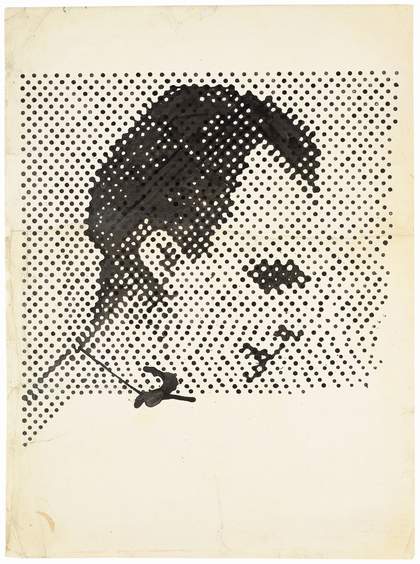
Sigmar Polke
Raster Drawing (Portrait of Lee Harvey Oswald) 1963
© The Estate of Sigmar Polke / DACS, London / VG Bild-Kunst, Bonn
MG The idea of time wasting also connects to boredom. What do you make of Polke’s Boredom Loop from 1969, where he stuck awkwardly curved stretches of masking tape on his studio wall and photographed them, with the word Langeweileschleife in lettering underneath? We haven’t included it in the exhibition because we couldn’t redo it, but Polke remade it a couple of times.
PF For me, that’s one of the key pieces – if I had to choose four or five works of his, this would be one of them. He redid it in Zurich in the mid-1970s for a show at a place called Ink. He had to fill this empty space, and it was at a moment when he wasn’t really keen on doing a lot, so he did another Boredom Loop. I remember it as much bigger than the 1969 version. Celebrating boredom was something that I was very interested in. It was in Boetti’s work too. This mentality is strongly present in our Equilibres series. As an artist, if you are always just receptive to the things with which the world entertains you and make your work in response to them, then for me that’s not so interesting. The moment when the higher beings are not talking to you, the moment when you are disconnected and go into this deep boredom… this is really a great experience. And then you go from there…
MG Yes, it’s interesting to think that Polke’s Boredom Loop came at the end of the 1960s after nearly a decade of painting things around him – food stuffs, consumables, printed newspaper photographs of holiday destinations and exotic icons, lovers. All these fascinating images. And then you get to boredom. Where do you think it leads him to?
PF It’s connected in a way to Höhere Wesen, to the higher beings, for me. To celebrate boredom was also to be against the whole idea of the ‘inspired’ artist. As if he were saying: ‘We can be bored instead.’ It reminds me of the English punk band Buzzcocks in their song Boredom: ‘I am living in this movie, but it doesn’t move me.’
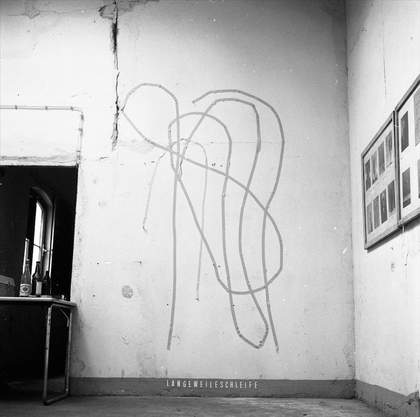
Sigmar Polke
Boredom Loop (Langeweileschleife) 1969
Tape, dimensions variable
courtesy Estate of Sigmar Polke, Cologne
© Manfred Leve, courtesy Manfred Leve
MG What do you make of his interest in the experience of hallucinogenic drugs, especially in the 1970s?
PF Well, this topic emerges earlier in the 1960s work. I own a print of Polke’s, Weekend House, where there is this weird flower which he lets grow in front of a bungalow. It’s a petit bourgeois modernistic building, a second-hand version of a Bauhaus icon, a lovely leftover of modernism, a low descendant of what had been very avant-garde architecture. And in front of that is growing this bizarre outsized plant. He was already interested in psychedelia – through the growing of the plant. It’s also there in another one of my favourite works of his, Reanimation of Bamboo, where he makes this sculpture of massive dry bamboo poles in a big pot with the idea that they will somehow be revived. Then in the 1970s pyschedelia became part of the whole hippy culture. There were two streams: the political hippies, and the psychedelic hippies, who were always bashed up by the political ones. For Polke this was not really a problem: he could see that you could be a political person and psychedelic at the same time.
MG You and David began showing your work in Cologne in the early 1980s. Did you see Polke much then?
PF You know, as an artist, however much you respect an older figure, you can’t simply keep on admiring them. In the early 1980s when Martin Kippenberger helped to organise our first show in Cologne, we went home one evening and Albert Oehlen started saying things against Polke. He admired him too, but this was very refreshing to us, finally hearing somebody criticising Polke.
MG Was that because of the turn he had taken after he returned to Europe following a massive trip in 1981, and with the Negative Value paintings that he showed in Documenta in 1982 – when he began to work in a much more private realm, experimenting with pigments and materials and abstraction?
PF Yes. We lost interest a bit at that stage. We went to his studio around that time, for the first and last visit, after meeting him in a bar called Pink Champagne. Instead of paintings, he showed us all these bottles with these colours. ‘This is poison, and here I have real gold,’ he said. It was like he was going into this alchemist thing, you know. Another thing happened on that same trip to Cologne. In the bar Kippenberger was really playing the bad guy, and saying politically incorrect things to everybody. Polke said to him: ‘It’s so good for me that you are now playing the arsehole.’ I thought it was like this historical moment when he passed to Martin the role of playing that figure. Polke didn’t want to do that anymore. He just wanted to paint.
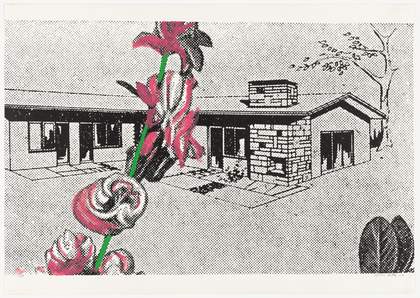
Sigmar Polke
Weekend House (Wochenendhaus) from Graphics of Capitalist Realism (Grafik des Kapitalistischen Realismus) 1967
Screenprint on paper, from portfolio of six, each 590mm x 839mm
© Estate of Sigmar Polke/DACS 2014, courtesy Museum of Modern Art, New York, Linda Barth Goldstein Fund, MoMA/SCALA Archives
MG What did you make of all those bottles of pigment in the studio?
PF Basically, my feeling was: ‘Err, well, I’m glad that’s interesting for him!’ But not for me. I could see though that it was super-exciting to him that he had new possibilities of how to fill a canvas. It seemed in fact that he cared more about all these materials, the gold and the poison, than about how these materials were distributed on the canvas. I loved this idea of focusing on the materials themselves like saying ‘the paint is the painting’. In his case the paint was radioactive material, all kinds of chemical stuff. It was only when I saw his Tate show in 2003 that I picked up interest in what he was doing at the time, with all those massive paintings of Texans shooting. There’s one other painting I want to talk about: The House of Nicholas from 1992 is an absolute masterpiece of the later Polke. One could claim it is the most theoretical painting about painting after Velázquez’s Las Meninas from 1656. It’s all about what painting is: what is the surface on which you paint, and what is the structure that is underneath it. The stretcher-bar structure itself makes the image, which repeats the drawing of the Saint Nicholas house, a well-known drawing exercise, and the fact that so-called adults can no longer believe in the figure of Saint Nicholas.
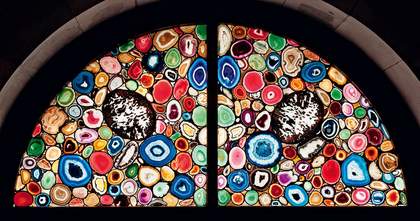
Agate window designed by Sigmar Polke for Grossmünster cathedral, Zurich, 2009
© Estate of Sigmar Polke/DACS 2014, courtesy Grossmünster cathedral
MG We started in Zurich with Polke’s time there in the 1970s, and let’s end there. One of his last major projects was his series of windows for the Grossmünster cathedral…
PF I really like them, especially the transparent stones, because they remind me a little bit of hippy shit. But they are so beautiful. It took me a while to accept them, but now when I go back each time, I think they’re great.
MG Is that because they are slightly antagonistic to some of the belief systems of the church, or is it that the agates have nothing to do with Christian iconography?
PF I have to compare them with Gerhard Richter’s window for the Cologne cathedral. Richter took out any kind of Christian iconography, but he kept in the colours of stained-glass windows and the atmosphere and light that you would find inside a church. Alongside the unusually coloured agates, Polke was not afraid of bringing in all kinds of iconography. Here again, there was a moment of psychedelia.

